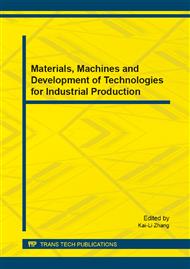p.64
p.71
p.76
p.81
p.86
p.90
p.94
p.100
p.105
Bonding Properties of Poplar Plywood with High Moisture Content Veneer
Abstract:
The poplar is largest plantation tree species of in China. However, poplar veneer is easily broken when subjected to drying for plywood. This work presents an orthogonal test to reveal the key technological parameters of poplar veneer with high moisture content (MC) on the bonding properties. The results showed that, veneer MC has a significant effect on internal bond (IB) and MC of obtained plywood, but has a light effect on the content of released formaldehyde. Resin content has a significant effect on IB, MC and content of released formaldehyde. Hot-press time has a significant effect on content of released formaldehyde; but has a light effect on MC and IB. The obtained optimal technological parameters of poplar veneer with high moisture content is, veneer MC of 26%, resin content of 11%, and hot-press time of 200s.
Info:
Periodical:
Pages:
86-89
Citation:
Online since:
August 2014
Authors:
Keywords:
Price:
Сopyright:
© 2014 Trans Tech Publications Ltd. All Rights Reserved
Share:
Citation:


